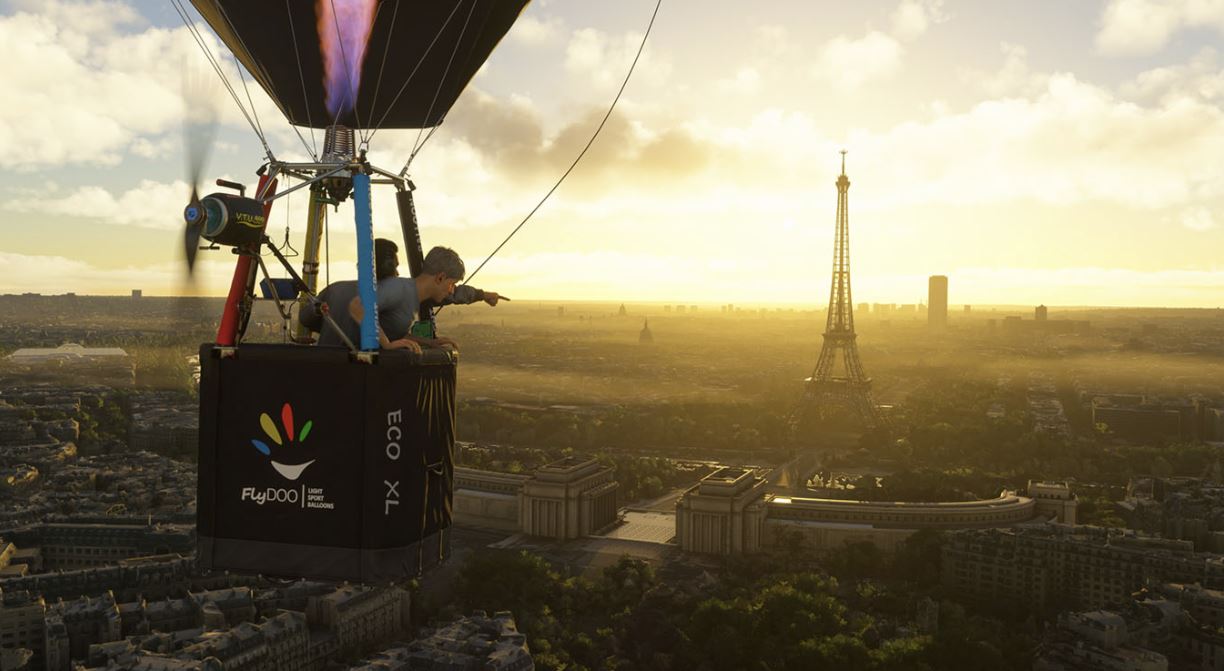
For over 40 years, Microsoft Flight Simulator has been an institution, evolving with advances in contemporary gaming technology to bring the most authentic flight simulation experience to users primarily on PC. After a lengthy hiatus, Microsoft Game Studios and Asobo Studio revived the franchise with the acclaimed Microsoft Flight Simulator 2020, setting a new bar for the series and bringing it to the Xbox Series X|S, reaching over 15 million unique users worldwide. Four years later, Asobo Studio is back to propel the franchise into the future with Microsoft Flight Simulator 2024, which is shaping up to be the most ambitious title in the long-running series to date.
Den of Geek recently got an extended hands-on with a pre-release build of Microsoft Flight Simulator 2024 and a chance to speak to the developers behind the game. Not only does Microsoft Flight Simulator 2024 feel like a natural evolution to its 2020 predecessor, but stands as the most expansive title in the franchise yet rather than a marginal leap forward. And while adding a whole bevy of new games and aircraft to fly, Microsoft Flight Simulator 2024 maintains the authentic feel and attention to detail that has made the series such a critical success for decades.
A More Powerful Microsoft Flight Simulator
Even though it’s only been four years since the previous flight simulator, Asobo Studio pulled out all the technical stops and took full advantage of modern technology to bring Microsoft Flight Simulator 2024 ahead of its predecessor by leaps and bounds. To help facilitate this, Asobo built a digital double of the world to function in real-time, constantly reflecting not just the time of day at a given location but replicating climate conditions based on the time of year and how it impacts flight. Asobo used everything from satellite imagery and aircraft scanning landscapes, where they were permitted by local authorities and governments, to bring their digital version of our world to life in the flight simulator.
“With flight simulators, I think it’s important to be as accurate as possible, whether it’s the plane physics, plane visuals, and it’s here,” observes Asobo Studio CEO and co-founder Sebastian Wloch. “Every step is a little bit closer to reality and now, with the technology of today, with satellite images, planes that can scan. Pretty much anybody can scan stuff, just with a camera. The difficulty is the scale of the planet. It’s huge and there are gigantic amounts of data.”
To accommodate the enormous amounts of data without putting an immense strain on users’ local hard drives, the majority of data is stored on cloud servers and then delivered in preprocessed packages as players load certain areas and conditions. Compared to Microsoft Flight Simulator 2020, the amount of critical data files and packets stored locally on user hard drives has gone down from 150 to 20-30. This is made all the more impressive with the knowledge that the ground textures in Microsoft Flight Simulator 2024 are approximately 4,000 times more detailed than they were in 2020. This is especially apparent with the ability for players to land and exit their vehicles, exploring their surroundings on foot.
“Flight Simulator was always a full representation of Earth,” Head of Microsoft Flight Simulator Jorg Neumann explains. “Now that they can land a helicopter anywhere and walk around, we said that we need to make it look as good as, at least, a first-person shooter or something. That is a need that drives innovation forward. We’re relentless but, when you have 15 million people playing something, that’s a pretty big motivator.”
A Wealth of New Features
The most striking thing about Microsoft Flight Simulator 2024, however, isn’t the significant upgrade to its presentation and increased reliance on cloud storage but the abundance of new features and game modes. 2024 is the first game in the series to feature a career mode, photography mode, mission mode, and challenge mode, complete with online leaderboards. Players create their own custom character in the simulator’s central hub and choose how they want to proceed, from the new modes to old standards, like free flight mode. Tentative plans for these additions were in the works from Asobo dating back to before the completion of Microsoft Flight Simulator 2020 before being revived and incorporated based on user feedback.
“Even before we launched 2020, we were already thinking of a career system and activities,” reflects Asobo Studio CCO David Dedeine. “We were super excited but the reality was, if we wanted to make 2020 good, we had to shelve those components and focus on something else. When we launched 2020, we did several surveys and in each of the surveys, from hardcore simmers to even people who never played a video game in general, the #1 thing across the board was we want more goals.”
With the digital world incorporating real-time data and MSFS 2024 featuring a wide array of geographic locations at launch, complete with their own conditions, there are three million unique mission types for users to engage in, from search-and-rescue missions to crop-dusting open fields. This, coupled with a range of difficulty levels and the vast amount of aircraft to choose from, makes these features varied and ambitious undertakings that players can get completely immersed in exploring. For Asobo, these features were only enhanced by the studio’s dedication to providing authentic simulation experiences, becoming a natural extension of the realistic core of Flight Simulator.
“It’s not about the number, it’s about the quality,” Dedeine points out. “If you want to make a believable scenario where you transport someone who just broke his leg at a ski station in the winter in the Alps and you need to bring this guy to a hospital, you need to make lots of different conditions to make it believable.”
The Asobo personnel emphasize that the addition of these new gameplay modes does not detract from the verisimilitude of flight simulation gameplay throughout the game. Instead, Asobo has found new and fun ways for users to explore the different ways Flight Simulator can be enjoyed with prescribed scenarios, wherever and however they want to pursue them. And with fan feedback overwhelmingly asking for new activities to engage in, Asobo has certainly delivered on that common request to make MSFS 2024 the ultimate, full-flight simulation experience.
Adding to the Aerial Armada
Of course, any flight simulator is nothing without its selection of aircraft for users to choose from and Microsoft Flight Simulator 2024 has an impressive array available at launch. There will be 70 aircraft available in the Standard edition at launch, with even more aircraft available Day 1 with the Deluxe and Premium Deluxe editions. This includes propeller planes, jet planes, commercial and military-grade aircraft, hot air balloons, airships, gliders, and bush planes. For the gliders and bush planes in particular, Asobo and Microsoft have been working closely to ensure these experiences have been enhanced, especially with the added detail to the terrain.
“Gliders in 2024 are some of the most realistic gliders that I’ve been able to personally feel in a long time,” declares Brandon Yaeger, co-founder and project lead of the development studio Got Friends. “Working with us, as the glider developer, we’ve been able to do a lot on that side, like bringing in a new navigation unit and making sure we stay true to conventional things, like winching and towing. I think that gliding was a niche in 2020 and I hope all the advancements with gliding in 2024 brings it more into the limelight because it truly does make the pilot experience flight in such a raw form.”
With gliders, users feel every change in wind current and the impact weather conditions have on flying, in addition to landing on the more meticulously rendered terrain. One of the slickest aircraft in the game isn’t even technically completed yet, with the experimental bush plane, the Draco X, included in the playable roster. To include the prototype in MSFS 2024, Got Friends has been working closely with the Draco X’s creator Mike Patey, innovating and testing out the prototype in the simulator and sharing the data as Patey shares information from his own real-world development.
“Working with him has been a unique experience because, not only are we creating his vision of what he wants in the future, but we’re experimenting as well,” Yaeger elaborates. “We’ve been able to experiment with the airframe and send information back to him. He’s been able to relay information back to us. We’re able to test it in the game. There is this weird cohesiveness there, which has been great to see. It feels like he’s innovating within the flight simulation as well as innovating within his work.”
The Evolution of Microsoft Flight Simulator
After a 14-year hiatus, Microsoft Flight Simulator returned bigger and better than ever under Asobo Studio and the team is looking to soar even higher with Microsoft Flight Simulator 2024. More than just a technical upgrade, the wealth of game modes and features, in addition to the usual environments and aircraft, have grown considerably as the most ambitious flight simulator on the market when it launches this November. In going bigger, Asobo Studio and its partners have ensured that new user accessibility is just as vital as the fidelity and authenticity of its presentation and handling.
“I’m excited to go up in the balloon and airship and see stuff because the fidelity is so amazing,” notes Christopher Burnett, co-founder of the development studio Working Title Simulations and a fan of Microsoft Flight Simulator since the early ‘90s. “Also, being on the Xbox platform certainly helps. That infrastructure lets people dabble and see if this is something that they think is cool. There’s a lot of democratizing that’s going on with flight sim because it’s more accessible.”
That democratization of Microsoft Flight Simulator, in turn, played a key role in informing the development of MSFS 2024. From the enormous user base for MSFS 2020, Asobo paid close attention to feedback from the game’s performance and desires from the community on how to develop a worthy follow-up that exceeded fan expectations. Neumann found this synchronicity and dynamic common ground with their users to lead to a “healthier” and personally rewarding development cycle for MSFS 2024 as he and the team prepare to share the latest title with the world.
“We almost completely reversed the typical way to make a game,” Neumann reveals. Typically, we sit in a room and design stuff. In this case, we asked ‘What do people want, what are their needs?’ and we reversed it completely. Our designs came from the community. I’ve been making games for over 30 years and I had never made games this way, and it’s better! I would never go back the other way.”
Microsoft Flight Simulator will be released on November 19 for PC and Xbox Series X|S.
The post Microsoft Flight Simulator 2024’s Stunning Ambition Makes It a True Next-Gen Game appeared first on Den of Geek.





